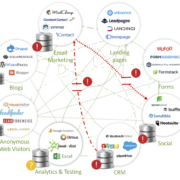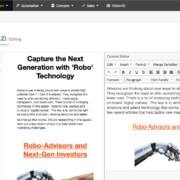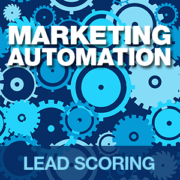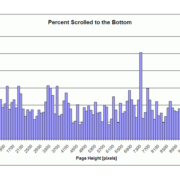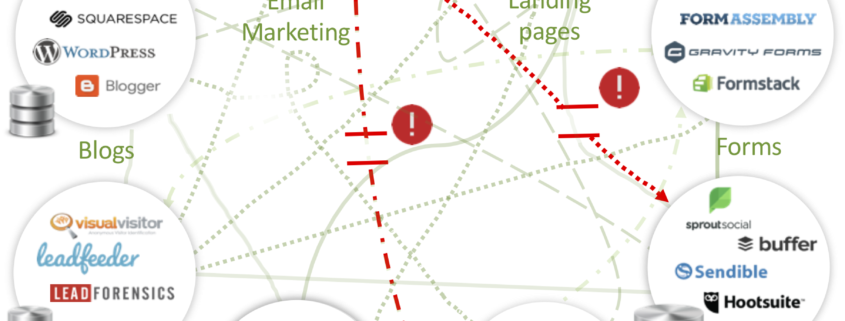
Consider Revenue Architecture When Selecting Your Tech Stack
Face it, buyers don’t care whether they are interacting with your marketing or your sales organization, they follow their buying process – often in an unstructured and unpredictable way. They self-sell on the web, research with influencers, and engage 1:1 with salespeople. An effective buyer experience across a dynamic buyer’s lifecycle requires that your revenue architecture is designed with a coordinated closed-loop process supported by an integrated technology stack.
We read a lot about Martech and SalesTech stacks. This is understandable because marketing and sales teams have traditionally pursued distinct missions with different needs. Yet if your marketing, sales, and service “front office” needs to be more integrated to support dynamic buyer pathways, you might need to re-think your technology stack. An integrated revenue process supported by integrated revenue technology helps deliver a single view of the customer and becomes more responsive and relevant as your buyers jig and jag along their dynamic buying processes.
What’s wrong with this picture above?
The image below depicts a typical revenue technology “revtech” stack for small and medium-sized businesses. The complexity and integrations become very challenging. Individual vendor contracts and fees create a costly solution. There are multiple systems to learn and use. It is difficult to connect siloed databases. Piecemeal analytics inhibit a 360-degree view of the customer. Compliance is more difficult with (GDPR, CAN-SPAM, CASL). Support is more difficult – who do you call when things break?
For larger or complex businesses, to achieve a single view of the customer, customer data will need to be drawn from multiple touchpoints and operational systems. This typically requires integrations between operational systems, marketing systems, and a data warehouse and business intelligence engine. Smaller businesses may be better positioned to use native revtech solutions “out of the box” to deliver the functionality and data management they need to run the front office.
In both larger enterprises and mid-market companies, the goal should be to simplify the tech stack architecture and remove some of the disparate parts. An integrated technology platform helps reduce the complexities.
Selecting Your Revenue Technology “RevTech” Stack
We use the term Revenue Technology (rather than martech and salestech) to describe the solutions that support customer acquisition, closed-loop marketing and sales, and customer relationship management. Broad categories (as depicted in the top image) include:
- Omnichannel (web, social, etc)
- Marketing Automation
- Sales Automation (CRM including customer service)
- Data Management / Integration
- Business Intelligence & Analytics
Other technologies that fit in the ecosystem and should be considered in your overall architecture include office solutions ( Office 360, Gmail / G Suite), website platforms (WordPress, ERP systems), customer service technologies and custom apps.
A key challenge when selecting technology components across these categories is the difficulty in integration, including maintaining, enhancing, cleaning, and analyzing critical customer data. It is important to consider both your functional needs and your data needs, including where the single truth exists for customer data – your “system of record” and the way data flows between systems.
Companies with complex sales and marketing processes and custom operational systems will often need customized integrations across multiple systems and data sources. They likely will need a data warehouse to achieve a single view of the customer by pulling data from various operational and marketing systems. Many small and medium-sized businesses can utilize a single customer database in their revtech stack. An integrated platform combines extensive marketing and sales functionality and a single customer database. HubSpot, SharpSpring, and Salesforce Cloud solutions are some of the solutions we work with that offer a more integrated approach out of the box.
With so many solutions available, how do you decide on the right solution architecture and components?
When selecting a revenue technology stack (including “martech” and “salestech”), it helps to begin with an understanding of your revenue architecture.
A revenue architecture considers the interplay and structures across three layers: your revenue strategy, your revenue systems and your revenue programs. By understanding the architecture and design across these layers, you will be able to select the technology architecture that adapts to your business.
How does your revenue strategy impact your technology needs?
- Are your product service offerings complex and variable or more standardized? This reveals a lot about the nature of the buy-sell process and the role of marketing and sales through the buying cycle.
- What is the size of your target market and volume of customers, members, and transactions? High volume / low dollar transaction selling differs from complex high-value or account-based marketing and sales.
- What is the buyer process across your different products and services? Are your buyers transacting instantly or are you engaging in a multi-step or complex process, e.g.: Problem/Need Recognition – Research – Evaluation – Decision – Negotiation – Post Purchase.
- How many channels and touchpoints do you have? Are you marketing at scale across channels like SMS, social media, email and direct mail? How complex is your 1-to-1 engagement with consumers, users, and subscribers over social media?
- What are the metrics across marketing and sales (e.g. volumes and pipeline stage metrics)? What do these metrics suggest about the budget for your revtech stack?
What revenue system (people, process and technology) do you use to engage buyers?
- For each product/ service, what is your end-to-end closed-loop revenue process? Are you transactional? account-based? is your process highly structured and routine or is it highly variable and skill-driven?
- What is the velocity of the lead to close process? Do buyers consider many products/solutions over a long cycle or self-sell transactions on the web?
- What is the role of marketing and sales across the customer acquisition process? Does your marketing team nurture leads and pass them off at a certain qualification point to a salesperson or team? Are marketing and sales teams collaborating on account-based marketing and sales? Is there a service level between marketing and sales?
- What type of skills do salespeople and marketers need? Is there a unified culture for sales – or individuals engaging their independent sales process and customer relationships?
- Will users use CRM / Marketing Automation in their primary dedicated day-to-day function, or will usage be more casual and intermittent? What does this suggest about ease of use? Complex CRMs may bring deeper functionality, but often require a more dedicated expert user and can be difficult to adopt for more intermittent users.
- How complex are your data requirements and data flows? What operational systems contain critical customer data?
What kinds of revenue programs and campaigns will you engage for demand generation, prospect nurture and selling?
- What kinds of top-of-funnel (TOFU) buyer engagement will you need, e.g. inbound, outbound, and account-based, customer “self-sell”, account buyers vs individuals, roles of influencers, etc.) Does marketing need advanced technology to create, tailor, and analyze digital ads, and emails and run multi-channel engagement across social media, SMS/text messages?
- What kinds of middle-of-funnel (MOFU) process for nurturing prospects, enabling self-selling, scoring and qualifying leads to grade your prospects based on other information such as what industry they work in, the size of their company, or job title?
- What does the bottom-of-funnel (BOFU) sales cycle look like ( length of cycle, size of deal, level of teamwork)
Individual Components vs Integrated Technology Platforms
Many companies consider CRM tools and Marketing Automation or email service providers (ESP) separately. While there are integrations between many systems, typically, these integrations are not adequate to deliver a 360-degree view of the customer. Technologies are constantly changing, and while the component approach may provide some modularity for “plug and play” and best of breed, these often come with a high cost from complexity and difficulty with integration.
You might consider solutions with native integrations that bring data together, supporting the information and process flows in your organization. Unless you have the budget and resources to effectively integrate disparate systems, the fewer component solutions involved in your process, the better. It is possible to integrate data across multiple components, but this is typically expensive and complex because data from each different system will not be compatible, and strong open APIs are required, along with the organizational skills to build and maintain these. You may think you have built-in flexibility with a modular component approach, yet your investment in integrations across these components quickly becomes a legacy system that locks you in. For this reason, many experts focus on the core stack ecosystem and the vendor behind the ecosystem to ensure a sustainable long-term solution.
Depending on your specific requirements, an integrated sales and marketing solution that combines marketing automation and CRM functionality in one platform is a great choice for closed-loop marketing and sales. These platforms deliver comprehensive marketing and sales functionality on a unified customer database. Examples include SharpSpring, HubSpot, and Salesforce Cloud. Other platforms like Marketo do integrate well with Salesforce. The costs of these platforms vary widely, so your business metrics and your budget will dictate the shortlist to look at.
Objective Solution Selection
Yikes, there are many things to consider in revtech solution selection.
Revenue Architecture provides a framework to consider how your revenue architecture aligns with your business architecture, and it describes the ‘DNA’ of your go-to-market model. This framework helps define the types of revtech functionality you will need, and the critical data flows across systems.
Consider an objective solution selection “OS2” approach that brings stakeholders together on this important decision. Where possible, consider the advantages of an integrated platform or ecosystem, and don’t get caught up in the latest cool technology fad or component that does not integrate well.

